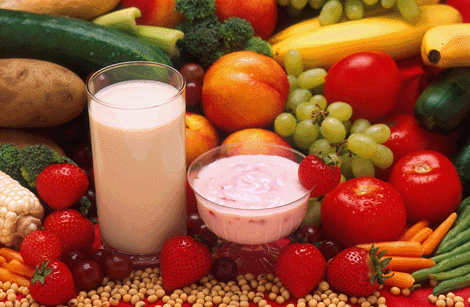| Glycemic Index (GI) Explaineds | ||||||||
| print the page | email the page |  |
|
|||||
- What is the Glycemic Index (GI)?
- How the Glycemic Index (GI) Works
- Blood Sugar Levels (of Glucose) Explained
- Glycemic Load (GL) Explained
- Glycemic Index (GI) and Diabetes
- Low GI Diet and Weight Loss
- Low-GI Diet vs Low-Carb Diet
- GI Labelling in Australia
- Examples of GI Rankings
What is the Glycemic Index?
 The Glycemic Index (GI) is a way of classifying the carbohydrate content of foods. The Glycemic response is characterised by the effect foods have on blood sugar levels after eating.
The Glycemic Index (GI) is a way of classifying the carbohydrate content of foods. The Glycemic response is characterised by the effect foods have on blood sugar levels after eating.
The main foods that cause a glycemic response are carbohydrates. Foods that have carbohydrates are:
Carbohydrates were previously classified as either '"complex" or "simple". The GI system replaces this concept.
How the Glycemic Index (GI) works
The GI measures how quickly glucose is released into the bloodstream after eating a particular food and is measured on a scale of 0-100. The slower glucose is released into the bloodstream, the less fluctuations there are in the amount of glucose (or sugar) that is released in the body (consistent and stable blood sugar levels are preferable and promote good health) and the more beneficial the food is.
Foods that have a high GI are broken down into glucose very quickly, so this glucose is released in the bloodstream very quickly. Foods that have a low GI are broken down into glucose very slowly, so glucose is broken down more gradually and the glucose is released more gradually in the bloodstream.
Glucose has a GI of 100 and is used as the base for comparison of the GI of all other foods. For example, a food that releases glucose in the bloodstream at half the rate of pure glucose has a GI of 50.
- Low-GI foods
These have a GI of 55 or less and include foods such as legumes (lentils, peas, beans, soy), mixed-grain breads, milk, yogurt, most vegetables and most fruits.
- Intermediate GI foods
These have a GI between 56 and 69 and include foods such as rolled oats, muesli, ice cream, sugar and orange juice.
- High GI foods
These have a GI of 70 or more and include foods such as white and wholemeal bread, potatoes, rice and honey.
Advertisement
Blood Sugar Levels (of Glucose) Explained
When foods that have carbohydrates in them are eaten, the carbohydrate is eventually broken down into glucose in the digestive system and then the glucose is released into the bloodstream.
Glucose is basically the simplest form of sugar - all carbohydrate foods get broken down into their simplest form in the body - glucose. The body uses glucose for energy in every single cell of the body.
There are two important organs which are involved in the release of glucose in the blood:
- Pancreas - this is the main organ that regulates the amount of glucose that is released in the blood, by secreting a hormone called insulin. Insulin is the hormone that allows glucose to enter the cells of the body which gives the cells the energy they require to function properly. The brain requires a lot of glucose energy to function properly
- Liver - this is the organ that stores unused glucose, in the form of glycogen. The liver breaks down glycogen and releases into the blood when the pancreas releases another hormone called glucagon, in response to low levels of glucose in the blood
In order to test for diabetes (or hypoglycaemica) blood glucose levels are taken when a person has been fasting.
- Normal blood glucose: 70mg-100mg per dL
- Prediabetes blood glucose: 110mg-125mg per dL
- Diabetes blood glucose: > 126mg per dL
Advertisement
The Glycaemic Load (GL) refers to the quantity of a particular food consumed and the blood sugar response in the body to that food.
For example, a 50g serving of a high-GI food (ie watermelon) would produce a slower blood sugar response than 500g of watermelon.
Glycaemic load (GL) is a combination of the quantity and quality of carbohydrate in a food. Foods with the highest GL are high in both GI and carbohydrate content (eg breads, breakfast foods and some fruits and vegetables). Foods with the lowest GL have low GI and low carbohydrate content (eg nuts, fish, cheese, meat). Moderate to low GL foods are preferable to be consumed regularly.
Portion control is also vital in relation to the GL of foods. If a food is low in GI, this does not mean large portions of it should be eaten on a regular basis. This is important to note not just for blood sugar regulation but also for weight control.
Glycemic Index (GI) and Diabetes
Diabetes is a degenerative disease which is basically due to the body's inability to release or use insulin properly and is associated with blood glucose levels that are too high. There are three types of diabetes:
- Type 1 Diabetes - is caused when the pancreas stops producing any (or much) insulin
- Type 2 Diabetes - is caused when there is an inadequate response to the insulin that is released (insulin resistance)
- Gestational Diabetes - this is a temporary type of diabetes, which affects some women when they are pregnant
Both Types I & Type II Diabetes result in too much glucose remaining in the blood, which causes a variety of symptoms such as frequent urination, continual thirst and tiredness.
People with diabetes are at higher risk for developing serious and deadly heart conditions as well as a range of other serious (and potentially) life-threatening conditions.
A low-GI diet is believed to be helpful to people with diabetes because low-GI foods release glucose into the bloodstream slowly and consistently than high GI foods. Low GI foods deliver carbohydrates more gradually to the bloodstream, without the sudden build-up of glucose that high GI foods produce, leading to hyperglycemia at first, then hypoglycemia when the blood sugar levels drop. Such fluctuations in blood sugar are not beneficial for healthy individuals and are potentially dangerous for diabetics.
Following a low-GI diet does not automatically mean weight will be lost on that diet. The GI only relates to the carbohydrate content of foods and does not take fats, proteins, calories/kilojoules or dietary fibre into consideration. It is important to consider overall calorie intake, as well as fat intake for weight management.
The GI is basically about making smarter carbohydrate choices. In addition to this, smarter fat choices need to be made at the same time by looking at the type of fat in the foods eaten - unsaturate (good) fats vs saturate (bad) fats. It is preferable to have a diet with a moderate amount of good fats and not to limit all fats altogether, as they are necessary for good health.
Since low GI foods take longer to be converted to glucose, they usually give a feeling of being full for longer than high GI foods and so make it less likely to over-indulge.
Low carbohydrate diets are currently the latest diets in vogue. Some of the low carbohydrate diets, such as the South Beach Diet and the SugarBuster! Diet are based on Glycemic Index. Some of the other low carbohydrate diets, such as the Atkins Diet and Zone Diet are not based on GI, but rather on excluding or limiting certain carbohydrates from the diet.
A low GI diet does not necessarily involve excluding all carbohydrates from the diet but instead is based on selecting foods that have a low GI rating, to enable weight loss and give healthier food choices.
In Australia, many foods have a GI label on their packaging. It is not mandatory to have a GI label on foods, but because it is the latest "buzz" word, many companies will label their food low GI to appeal to all the people who are on a variety of diets.
When choosing a food based on its GI, it is important to note that GI relates to how quickly glucose is released into the bloodstream. The GI does not specify how much fat, calories or carbohydrate is in the food, so it is not the only indicator for the food's nutritional benefits. All these factors must be taken into consideration together when choosing foods. In addition to this, if a food is low GI this should not be seen as permission to over-eat that food, as it could be high in calories and/or fat too.
The following tables show the GI rankings of various common foods.
FOOD |
GI Ranking |
|---|---|
Rye Bread |
76 |
Bagels |
72 |
White Bread |
70 |
| Wholemeal Bread |
69 |
Pita Bread |
57 |
| Fruit Loaf |
45 |
Wholegrain Bread |
45 |
FOOD |
GI Ranking |
|---|---|
Rice Bubbles |
89 |
Cornflakes |
84 |
Puffed Wheat |
80 |
| Vita Brits |
61 |
Special K |
54 |
| Muesli |
43 |
Porridge |
42 |
FOOD |
GI Ranking |
|---|---|
Watermelon |
72 |
Rockmelon |
65 |
Banana |
55 |
| Mango |
55 |
Kiwi Fruit |
52 |
| Grapes |
46 |
Orange |
44 |
| Apple |
38 |
Canned Peaches |
31 |
| Dried Apricot |
30 |
Cherries |
22 |
FOOD |
GI Ranking |
|---|---|
Calrose Rice |
83 |
Sunbrown Quick Rice |
80 |
Brown Rice |
76 |
| Long Grain White Rice |
76 |
Taco Shells |
68 |
| Basmati Rice |
58 |
Doongara Rice |
54 |
| Buckwheat |
54 |
Instant Noodles |
46 |
| Spaghetti |
41 |
Ravioli |
39 |
| Vermicelli |
35 |
Egg Noodles |
32 |
FOOD |
GI Ranking |
|---|---|
Broad Beans |
79 |
Baked Beans |
48 |
Chick Peas |
33 |
| Butter Beans |
31 |
Lentils |
29 |
| Kidney Beans |
27 |
Soya Beans |
18 |
FOOD |
GI Ranking |
|---|---|
New Potato |
65 |
Pontiac Potato |
65 |
Beetroot |
64 |
| Sweet Corn |
55 |
Sweet Potato |
54 |
| Carrots |
49 |
Green Peas |
48 |
More information
To learn more, go to the official Glycemic Index web site
Advertisement
references
- Glycemic Index, www.glycemicindex.com.au, accessed 5 April 2007
- McGuire M, Beerman KA, Nutritional Sciences: From Fundamentals to Food, 2007 Thomson Wadsworth USA
- Rolfes SR, Pinna K, Whitney E, "Understanding Normal and Clinical Nutrition" 11th Edition,, 2006 Thomson Wadsworth USA


